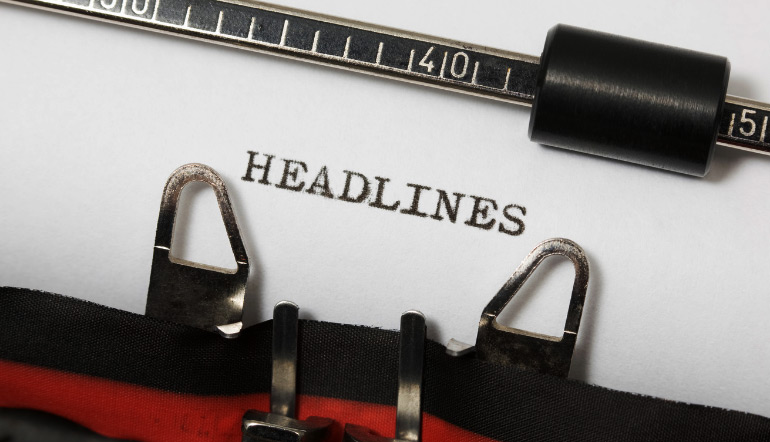
Headlines are the first thing that people see when they come to your store’s blog before they decide to click through and read your story.
Even now, at the very beginning of this lesson, simply from a point of view of a reader, you are probably able to discern that this:
5 Unexpected Ways Electric Bikes Actually Save Money
is a much better headline than …
The Best Electric Bike Models
However, it is not always so transparent and there are many factors and nuances that you need to explore. One badly chosen word or even one word too many can turn your stellar title into an average one.
We’ll tackle the most important points in this lecture and teach you how to create effective headlines.
Here is how that is going to work:
Firstly, we’re going to teach you about the importance and usability of headlines, how to structure your ideas i.e. how to actually begin working on writing a headline. We’re also going to teach you about the elements that make up a good headline.
Moreover, we’re going to show you some examples of headlines that get clicked, as well as the structure and aspects of different types of headlines.
The next thing we’re going to talk about a bit is using search engine keywords in your headlines.
Finally, we’re going to provide you with a whole bunch of templates for writing catchy headlines.
So, let this exciting journey begin!
The Importance of Writing Captivating Headlines
An advertising genius David Ogilvy said the following in his book ‘Confessions Of An Advertising Man’:
Although this was said in 1963, it still stands true even today!
In other words, this means that 8 out of 10 people will read headline copy, but only 2 out of 10 will read the rest.
According to Copyblogger, this is the secret of the power of the headline, and the reason why it so highly determines the effectiveness of the entire piece of writing.
Headlines completely dominate the chances that somebody will make the decision to read your story further than the headline itself. That means we need to put some serious effort into getting them right in order to truly be a professional eCommerce copywriter.
Thus, your headline is the first thing you should think about. When you write an engaging and descriptive headline first, often it makes the process of writing the article far more straightforward.
Your headline tells readers what they will get in exchange for their time.
When you see some examples of headlines in this lecture, you’ll realise that writing them is more than just science. It’s a bit of an art!
Mastering any type of art takes more practice than reading a set of rules. Therefore, we’ll offer you some guidelines, but it’s much more useful to analyse the examples.
Let’s start with explaining the key features of excellent headlines really quickly and then jump to a few examples of good and bad headlines to illustrate this point more clearly and vividly.
Learning Key Features of Magnetic Headlines
In general, if your headline encompasses the following elements, then it will probably be quite successful in drawing user engagement.
- Useful: Is the promised message valuable to the reader?
- Ultra-specific: Does the reader know what’s being promised?
- Unique: Is the promised message compelling and remarkable?
- Urgent: Does the reader feel the need to read now?
Besides these cleverly crafted features, there are several more rules that you can use to make your headlines more appealing.
For example, use numbers or percentages to draw attention, make sure your text delivers the promise from the headline, mention celebrities or current topics where possible and many more.
Also, it is very important to include emotionally powerful words in your titles because that makes them more engaging. Here is a list that you my find useful:
You can learn more about these details, backed up with some interesting statistics here:
Now, let’s see how these work in the following examples:
Example #1
Take a look at this example of a captivating and effective blog post headline from an eCommerce store Gazebos Australia: 17 Ideas to Sell More at your Market Stall.
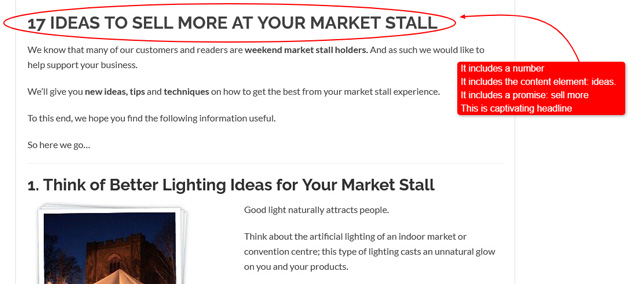
They could have written something like Learn About Market Stalls instead. Luckily, they didn’t.
What makes the first solution so captivating and much better than the second one?
First of all, the use of the number format in headlines increases its chances to get clicked and shared more.
Furthermore, ‘13 Ideas’ sounds unambiguous and clear enough about what the article offers to the reader. They know exactly what they’ll get when they click on it.
Next, the phrase ‘Sell More at your Market Stall’ is catchy enough because it explicitly states how the reader will benefit from the article. Everyone wants to make money when they’re a market stall holder, which is why this phrase hits the target here. It’s only left to fulfil that promise in the text.
Could this headline be created even better? Probably.
Perhaps they could’ve included phrases like ‘Easy Ideas’ or even ‘ Secret Ideas’ to make it stickier but it’s far better than Learn About Market Stalls we mentioned above or any other similarly dull option.
Example #2
Now take a look at our next example. Which of these would capture your attention fastest:
- I Made Gwyneth Paltrow’s Recipes for My Boyfriend. Here’s What Happened,
- Learn about Gwyneth Paltrow’s New Cookbook, or
- Gwyneth Paltrow’s Diet?
The first one, of course! Right?
Actually, this is also a real-life example of an article about celebrities from Barnes&Noble, which uses this section of their website to increase the number of the visitors. They actually sell books.
Everyone would probably agree that Gwyneth Paltrow’s Diet is a really boring option, as is Learn About Gwyneth Paltrow’s New Cookbook. But what’s so special about the first option? Let’s see.
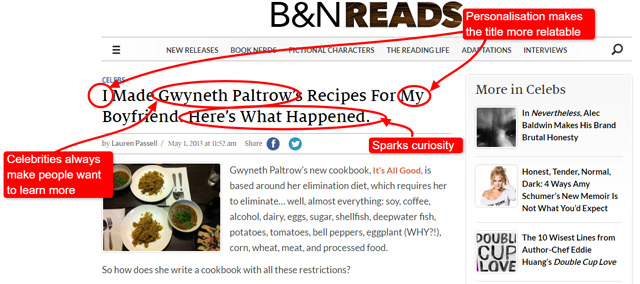
First, mentioning of a celebrity name is always interesting and people love learning the facts from their lives.
Then, they used the personal pronouns that make the title and the article relatable. Using ‘I’ and ‘my boyfriend’ makes people feel like they are reading a story that can happen to them. Something that is relevant to their experience.
The next important phrase here is Here’s What Happened. It sparkles a lot of curiosity. It is fun to learn what would happen to an average-Joe if he tried to eat like a celebrity. It indicates to the reader what type of content they can expect if they click on that headline.
Example #3
Here’s another example of a captivating headline from EatDrinkPaleo to learn from: 20 Awesome Spiralizer Recipes To Try Today. It is from a blog that is a part of an eCommerce website on which the author sells her books.
Let’s see why it’s much better than just e.g. How to Use Your Spiralizer.
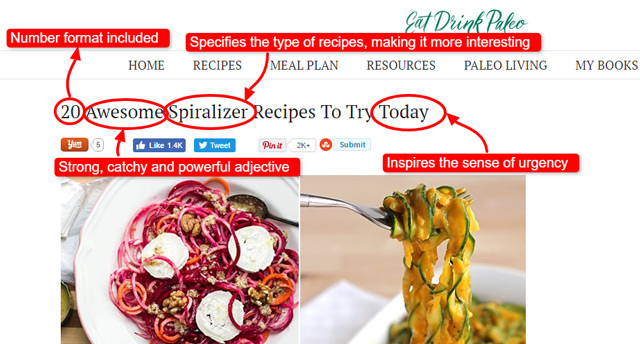
In this example, we can also notice the number format, which indicates that the type of the article is probably a listicle.
We can also notice the use of some catchy and powerful adjective: Awesome. So, you don’t just get a lot of any recipes, you get a list of awesome recipes. Isn’t that much better?
It provides the reader with further reassurance since the author’s strongly recommending the recipes in the article to them.
Then, the word Spiralizer narrows down the types of recipes you will be given. It is a great idea because just some 20 recipes doesn’t really spark the interest. What 20 recipes? What makes them special? Well, they will put that spiralizer you bought into good use.
You can see, this heading doesn’t just promise a lot of awesome recipes, it subliminally solves another issue that some people have – making the most of an appliance that is not used that often. It adds value!
Finally, by using the phrase Today, the copywriter increases the sense of urgency and invites the reader to action. At the first glance, the topic seems time-sensitive, that is to say, it’s only relevant for a short period of time, which creates the urge to act in the reader.
Although, you can try those recipes anytime you like, the heading compels you to do it today. Starting by reading the article.
Bear these things in mind next time you’re supposed to create magnetic headlines for your blog posts.
Now, let us show you HOW to create them.
Writing Headlines That Get Clicked
Let’s analyse some strategies on writing headlines that get clicked, which proved commercially viable. First, we’ll talk about the very process of how to start writing a headline and then we’ll proceed and show you how to make it truly magnetic.
And how do you start writing an article? Here’s what you should do:
Write the Headline First
If you write your article first, you need to go back and think of how to present it to a new reader. On the other hand, if you make a promise in the headline, you can write to fulfill the commitment made in it. This is massively helpful for writers in keeping their articles to-the-point and easy to read.
That’s why it is a great idea to always create a working title.
A working title is the initial title of your article as you are writing it. It doesn’t have to be perfect but it will serve as a guide to keep you on-topic.
It may also be helpful to write down several working titles so that you are not limited to just one. You can always edit your working title once your text is completed. You can make it more compelling, reflective and thoughtful for your readers.
The title should capture your reader’s attention. It can be thought-provoking, funny, personal, controversial, in the form of a question, or an opinion and the like, as shown below.
Let’s illustrate this further with an example.
This is what a working document may look like while a copywriter’s working on it:
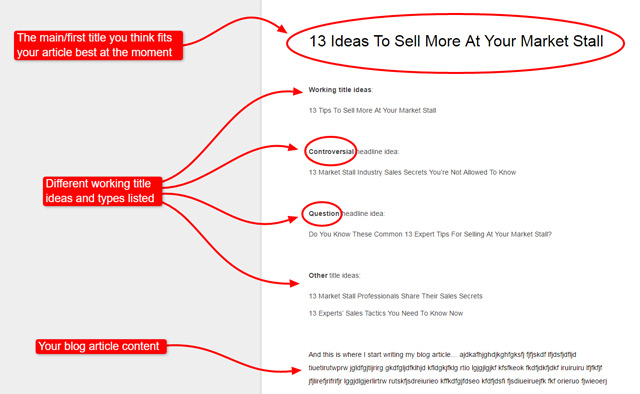
It’s extremely useful to put all your ideas into your Google document because it allows you to work through a whole bunch of ideas, to add and/or change whatever you want to whenever you want to during the working process.
For instance, you know you need to have 13 ideas about sales at market stalls, but you can always switch words around as shown below:
- 13 Ideas To Sell More At Your Market Stall
- 13 Tips To Sell More At Your Market Stall
- 13 Tactics To Sell More At Your Market Stall
- 13 Secrets To Sell More At Your Market Stall
You see?
The first one will probably be the main heading you think you’ve got at that very moment. However, when you finish your writing, you might think that another one fits your blog article far better than what was your first choice.
All in all, you can finalise the title once your content is in place. When you have finished your writing, check whether the title accurately describes what you’ve written. If not, rewrite it. Update it to make it more appropriate for your content. Make it concise, optimised for SEO, and accurate.
When writing for an eCommerce store, you will soon realise that a lot of traffic is generated from the ‘How to’ articles. You can create those to add value to teach people how to use the product your eCommerce store offers.
Here is a nice ‘How to’ article from Gazebos Australia below.
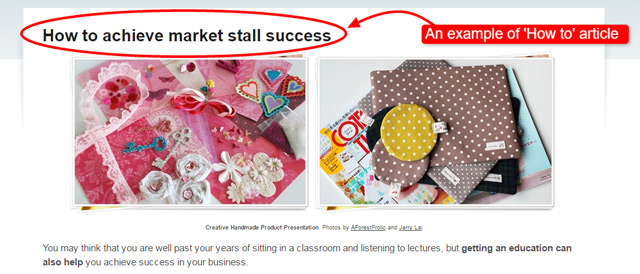
So, what can we do to make them even more clickable? Let’s see.
Double the Ritz!
A very simple strategy to use in writing hugely popular ‘how to’ articles is to teach people how to do two things instead of one. It can follow the following format:
How to [Complete a Task] and [Complete Another Task]
A good eCommerce example of this is:
How To Present Your Merchandise Beautifully And Sell More
The power of that headline really came from the fact that the second benefit (selling more) followed on logically from the first (present your merchandise beautifully).
There are many potential articles that use this exact formula that could be written about selling at market stalls, just to use it as an example:
- How To Build and Maintain a Wooden Gazebo For Your Market Stall
- How To Design Your Own Professional Market Stall And Earn More
- How To Branch Out And Sell More With Your Market Stall
- How To Use Unique Recycled Products For Your Market Stall And Help Save The Planet
The possibilities for this type of ‘how to’ article are exciting and up to your imagination.
Add an Extra Benefit
Another common and very effective tool for writing ‘how to’ articles is to add an extra benefit to the headline (and then fulfil the promise of the headline in the content, of course). The general formula for this is:
How to [Mundane Task] That [Rewarding Benefit]
Again, this exact formula has many possibilities:
- How To Choose The Best Gazebo That Will Make You A Winning Market Stall
- How To Display Products At Your Market Stall That Will Get You Increased Sales
- How To Present Your Products That Will Pique People’s Curiosity
You get the idea.
What About Just ‘How’ Articles?
It’s true that just ‘how’ (rather than ‘how to’) articles can also work very well. Something about the word ‘how’ has a deep connection to people’s desire to know about things. A couple of famous headlines are these:
- How I Improved My Memory in One Evening
- How I Made a Fortune With a ‘Fool Idea’
Now the important part about writing these type of articles, as we mentioned before, is to fulfil the promise that you made in the title. There is no use having a great and compelling title if you don’t actually teach people what you promised.
Here’s an example of of how this should be done: How to: Wear a denim jacket, five ways:
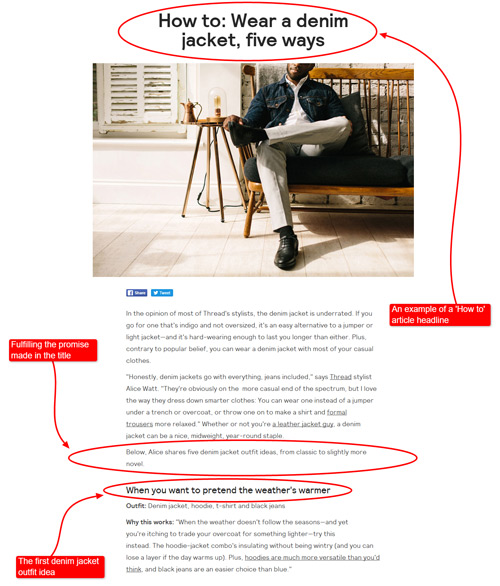
With a bit of sculpting though, it is possible to craft a story that will have people referring to it for a long time.
Nevertheless, being able to use search engine keywords in your headlines properly can do no harm. Quite the opposite! That’s why we’re going to talk a bit about that in the next section.
Including Keywords Into Headlines
Keywords are the currency of search engines and it certainly helps to know a little bit about them.
Many stores ONLY go after search engine traffic. It’s NOT advisable to do so. However, that doesn’t mean that the Search Engine Optimisation (SEO) effects of keywords should be totally ignored.
You want your articles to be readable for people, not search engines only and that is where you should concentrate.
Therefore, here are a few things to remember when writing headlines:
- Think about what people might type into Google to find your story.
- Try to include your keywords in your headline (preferably towards the beginning).
Check out this example to see how it works. Here’s the link to the full article Inspirational Etsy Products to Sell in Market Stalls, whereas you can see the keywords we used in our Google search below.
You see how they match to the article headline? That’s why this article occurs first in our search results. Got the point?
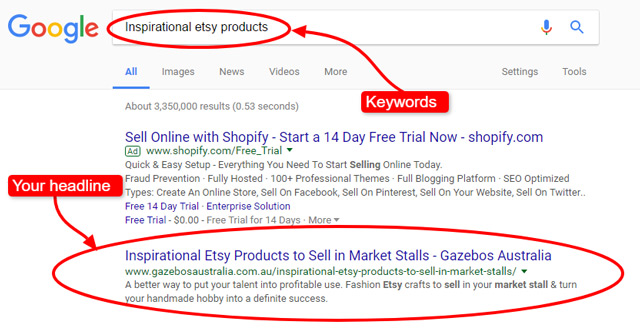
To get a better understanding of using keywords and find out whether they really matter, you can refer to this Copyblogger’s blog post. According to it, ‘doing keyword research is a free or low-cost window into the mind of your target audience’. Go and find out how and why.
A constructive piece of advice to follow: favour the headlines that appeal to humans over the headlines that appeal to search engines most of the time – if you can strike a headline that does both then that is fantastic!
Generally speaking, good news is that you can always make progress and perfect your skills over time no matter what you do. The same goes for writing headlines, of course.
Improving Headline Writing
Fortunately, there’s much we can do to improve our headline writing, as we already mentioned.
Advertising people have been studying headlines and their effects on readership for over 70 years and there are a lot of ways we can incorporate their knowledge into our own work.
Luckily, the findings aren’t really too difficult to understand or implement. Often times it’s simply a matter of adapting one of the many ‘headline formulas/templates’ that have been proven to work for other people.
So, here are some useful ones.
Templates for Headlines
Some headlines are more effective than others. Here are some helpful templates. You can use these as inspiration and a guideline to generate new ideas for store products and blog articles. Just replace [blank] with whatever topic you want to write about.
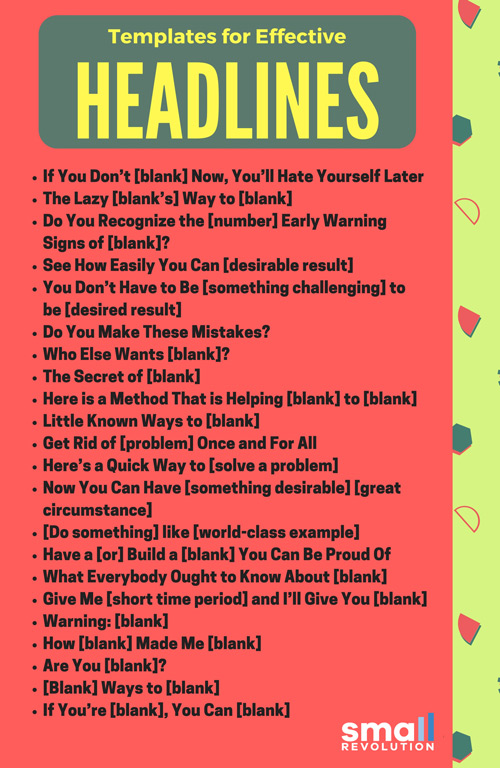
You get the idea. Don’t feel it’s necessary to stick to these exact formulas for everything you write. However, remember that they have been tried and proven and it’s a great way to almost force readers onto your articles.
Further Reading
Here are some fantastic expert articles that you can read in order to learn more about this topic.
They’re undoubtedly going to help you thoroughly understand how to craft perfect enticing headlines for your blog posts.
- https://bobwp.com/ultimate-guide-seducing-your-blogs-readers-with-enticing-headlines/
- http://writtent.com/blog/11-ways-write-damn-good-headlines/
- https://blog.hubspot.com/marketing/data-driven-strategies-writing-titles-headlines#sm.0001x8292dxaxdvnv5j1pjth8hghw
- https://blog.hubspot.com/marketing/a-simple-formula-for-writing-kick-ass-titles-ht#sm.0001x8292dxaxdvnv5j1pjth8hghw
- https://blog.hubspot.com/marketing/types-of-blog-headlines#sm.0001x8292dxaxdvnv5j1pjth8hghw
- https://blog.kissmetrics.com/how-to-write-headlines/
- https://blog.bufferapp.com/headline-formulas
- http://neilpatel.com/blog/how-to-give-your-content-wings-we-analyzed-11541-viral-articles-from-2016-to-uncover-the-secret-formula/
- https://coschedule.com/blog/content-marketing-headlines/
- https://coschedule.com/blog/write-better-headlines/
- https://coschedule.com/blog/content-writing-tips/ especially tips 8 and 9
These are some tools you may also find useful:
- https://coschedule.com/headline-analyzer
- https://www.portent.com/tools/title-maker
- https://www.online-utility.org/text/analyzer.jsp useful for keywords research
Once you master these skills, your readers won’t be able to resist the articles you’ll write.
Enjoy the reading!
But first, let’s just put everything we’ve learnt here in a nutshell.
In Summary
Although your headline is the first impression, make sure it’s not the only impression you’ll leave on your potential readers. Remember to fulfill the promise you made in the headline by providing valuable content in the story.
You’ll know your headline is impressive if:
- it accurately conveys the content of your article
- people can get what the story is about just by taking a glance at it
- it’s straightforward and intriguing
- it arouses your reader’s intense emotions
- it’s prominent for both users and search engines
- it makes a compelling promise and offers readers a reward for reading
By following these simple guidelines, you’ll be able to make your headlines turn browsers into readers of your articles. Remember to keep it easy to digest and to back it up with the text itself.
Good luck!
Now, it’s time for you to rock! Do the quiz and shine! We’re looking forward to your success!
